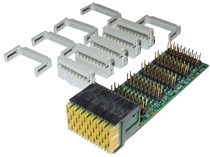VPX RTM access simplified: Technobox 8600 paddle card eases rear signal access and interconnects for VPX
February 02, 2018
Product

Solution Simplifies VPX Rear I/O Access for Testing and Interconnect
 |
| Technobox 8600 VPX Breakout Paddle Card |
The Technobox VPX paddle card provides a convenient, easy to use tool to break out rear I/O on a VPX backplane into more user friendly 0.1” headers. Five 18-pin headers, each representing a Fat-Pipe, can be used for test access, interconnections within planes, and external connections.
The VPX paddle card is conceptually similar to the “P2” paddle cards found in VME bus applications. It is not a standard VITA 46.10 Rear Transition Module (RTM), and therefore allows any positioning of the paddle card on the VPX backplane at every odd wafer position to bring out the specific signals of interest. Multiple VPX paddle cards can be placed next to each other to extract signals from the VPX backplane.
The Paddle Card consists of a 16-wafer VPX “RP1” connector from which the wafers are wired to four 18-pin 0.1” dual row headers. An additional 18-pin header collects the single ended signal from the odd wafers.
The differential pairs are routed differentially to the headers such that a twist-and-flat ribbon cable can be used to convey the signals to external equipment. 16 of the 18 pins are used for the differential pairs, while the remaining two are used for common mode signal ground. The single ended signals have a Ground per signal resulting in an alternating Single-Ground presentation on a ribbon cable.
For customer convenience, the VPX paddle card is supplied with five 18-pin IDC headers, along with the strain reliefs. Customers can provide their own readily-available ribbon cable materials, needing only a bench press to affix the ribbon cables to the IDC headers.
The VPX paddle card avoids sometimes clumsy and confusing individual “wafer cables,” and provides improved cable management. It is priced very competitively with these other solutions.




